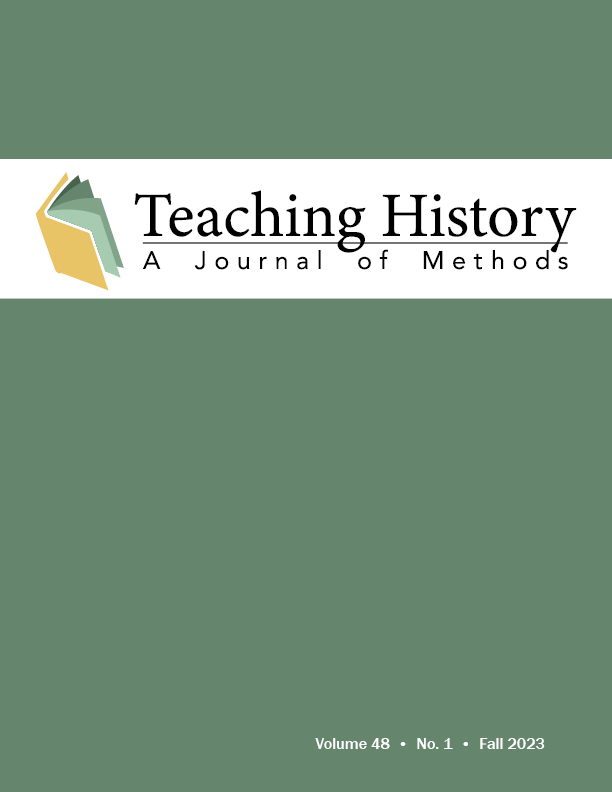Phantasmagoria 101
Teaching and Learning Haunted History Beyond the Classroom
DOI:
https://doi.org/10.33043/TH.48.1.84-90Keywords:
critical thinking, educational theater, Experiential Learning, ghost stories, local history, public engagementAbstract
A recently-formed undergraduate organization, interested in the paranormal, envisioned promoting themselves by hosting a new university event: a haunted tour of their campus. To realize this production, they learned how to identify, examine, and evaluate primary source materials in order to compile cohesive narratives out of facts recovered from both oral histories and archival records. Those efforts, while impressive in their own right, are made even more so considering they were extracurricular and student-led. Paranormal-themed scholarship empowered this undergraduate organization to engage their local community, raise their budget thirty-fold, and increase their membership a hundred-fold. This is their story…
Downloads
References
Martha Lincoln and Bruce Lincoln, “Toward a critical hauntology: bare afterlife and the ghosts of Ba Chúc,” Comparative Studies in Society and History 57, no. 1 (January 6, 2015): 191-220, https://doi.org/10.1017/S0010417514000644.
Yanique Chuntall Leonard, “They Won’t Stay Dead: University of West Georgia Ghostlore” (M.A. Thesis, Carrollton, Georgia, U.S.A., University of West Georgia, 2018), https://www.proquest.com/docview/2050059965/abstract/FC90E2BE822D490FPQ/1.
Tamara Chase Coleman, “Place-Based Education: An Impetus for Teacher Efficacy” (Ph.D. Dissertation, Kalamazoo, Michigan, U.S.A., Western Michigan University, 2014), https://scholarworks.wmich.edu/dissertations/370.
Garret D. Langlois et al., “The North American Beaver (Castor canadensis) is Recolonizing the Llano Estacado,” Western North American Naturalist 82, no. 1 (March 4, 2022): 190–195, https://doi.org/10.3398/064.082.0120.
Raider Power of Paranormal, “Raider Power of Paranormal,” TechConnect, October 2019, https://techconnect.dsa.ttu.edu/organization/raiderpowerofparanormal.
Colin Dickey, Ghostland: An American History in Haunted Places (New York, New York, U.S.A.: Viking Press, 2016).
Anna P. Kambhampaty, “Many Americans Say They Believe in Ghosts. Do You?,” The New York Times, October 28, 2021, sec. Style, https://www.nytimes.com/2021/10/28/style/do-you-believe-in-ghosts.html.
Wilkinson College, “Paranormal America 2018 - Chapman University Survey of American Fears,” The Voice of Wilkinson (blog), October 16, 2018, https://blogs.chapman.edu/wilkinson/2018/10/16/paranormal-america-2018/.
Tony Silva and Ashley Woody, “Supernatural Sociology: Americans’ Beliefs by Race/Ethnicity, Gender, and Education,” Socius 8 (March 10, 2022): 1–18, https://doi.org/10.1177/23780231221084775.
Julie Rugg, “Funerary Heritage Tourism: Definitions and Principles,” Revista Murciana de Antropología 28, no. 2021 (December 19, 2021): 31–58, https://doi.org/10.6018/rmu.435441.
María Genoveva Dancausa Millán, María Genoveva Millán Vázquez de la Torre, and Ricardo Hernández Rojas, “Dark Tourism in Southern Spain (Córdoba): An Analysis of the Demand,” International Journal of Environmental Research and Public Health 18, no. 5 (March 8, 2021): 2740, https://doi.org/10.3390/ijerph18052740.
Richard Wesp and Kathleen Montgomery, “Developing Critical Thinking Through the Study of Paranormal Phenomena,” Teaching of Psychology 25, no. 4 (October 1998): 275–278, https://doi.org/10.1080/00986289809709714.
Lou Manza et al., “Exposure to Science Is Not Enough: The Influence of Classroom Experiences on Belief in Paranormal Phenomena,” Teaching of Psychology 37, no. 3 (June 29, 2010): 165–171, https://doi.org/10.1080/00986283.2010.488554.
Alison J. Head and Michael B. Eisenberg, Truth Be Told: How College Students Evaluate and Use Information in the Digital Age (Information School, University of Washington: Project Information Literacy Research Institute, November 1, 2010), 72, https://projectinfolit.org/publications/evaluating-information-study/.
Library Journal, First Year Experience Survey: Information Literacy in Higher Education (New York, New York, U.S.A.: Credo Reference, 2017), 47.
School Library Journal, Information Literacy/College Readiness Survey: A Survey of U.S. High School and Middle School Librarians (New York, New York, U.S.A.: Credo Reference, June 2019), 79.
Solomon K. Smith, “Stepping Out of the Classroom Into Virtuality: Using MMORPGs to Teach History,” Teaching History: A Journal of Methods 42, no. 2 (November 4, 2017): 73–82, https://doi.org/10.33043/TH.42.2.73-82.
Karolina Ćwiek-Rogalska, “‘It’s scary here.’ Haunted landscape as a research tool to look into post-expulsion landscapes,” Polish Journal of Landscape Studies 3, no. 6 (October 9, 2020): 27-47, https://doi.org/10.14746/pls.2020.6.2.
David Waldron, “How Folklore Informs History,” Agora 58, no. 2 (June, 2023): 18–21, https://search.informit.org/doi/10.3316/informit.051751040401463.
Michael Clinton, “‘I’ll Remember That’: Oral History, Service Learning, and Historical Understanding,” Teaching History: A Journal of Methods 40, no. 2 (November 1, 2015): 107-116, https://doi.org/10.33043/TH.40.2.107-116.
George White, Jr., “Crafting History: On Oral History Projects, Experiential Learning, and a Meditation on Teaching and Learning,” Teaching History: A Journal of Methods 38, no. 1 (May 1, 2013): 23–38, https://doi.org/10.33043/TH.38.1.23-38.
United Press International, “Lubbock Boy Tells of Fatal Plunge,” Dallas Morning News, February 13, 1971, sec. D, https://infoweb.newsbank.com/apps/news/document-view?p=WORLDNEWS&docref=image/v2%3A0F99DDB671832188%40WHNPX-0FD52C03BB40F8DF%402440996-0FD52C04324990B9%4032-0FD52C07DFC58BA6%40Lubbock%2BBoy%2BTells%2Bof%2BFatal%2BPlunge.
James Boyett, “Dead Youth Discovered in Tech Elevator Shaft,” University Daily, February 12, 1971, http://collections2.swco.ttu.edu/handle/20.500.12255/127556.
Alexandra Alter, “Book Bans Rising Rapidly in the U.S., Free Speech Groups Find,” The New York Times, April 20, 2023, sec. Books, https://www.nytimes.com/2023/04/20/books/book-bans-united-states-free-speech.html.
Angel Eduardo, “Why ‘Sensitivity Readers’ Are Bad for Free Speech, Art, and Culture,” FIRE Newsdesk (blog), The Foundation for Individual Rights and Expression, March 31, 2023, https://www.thefire.org/news/why-sensitivity-readers-are-bad-free-speech-art-and-culture.
Tyler Brunner, “Censorship in History Textbooks: How Knowledge of the Past Is Being Constructed in Schools,” Ursidae: The Undergraduate Research Journal at the University of Northern Colorado, McNair Scholars Edition, 3, no. 2, article 9 (January 2016): 40–56, https://digscholarship.unco.edu/urj/vol3/iss2/9/.
Irving L. Finkel, The First Ghosts: Most Ancient of Legacies (London, U.K.: Hodder & Stoughton, 2021).
Suzanna Cisneros, “Caring for Families and Students,” Daily Dose (blog), January 28, 2016, https://dailydose.ttuhsc.edu/2016/january/caring-for-families-and-students.aspx.
Downloads
Published
How to Cite
Issue
Section
License
Copyright (c) 2023 Garret D. Langlois, Nicola R. Astles

This work is licensed under a Creative Commons Attribution-NonCommercial-NoDerivatives 4.0 International License.
By submitting to Teaching History, the author(s) agree to the terms of the Author Agreement. All authors retain copyrights associated with their article or review contributions. Beginning in 2019, all authors agree to make such contributions available under a Creative Commons Attribution-NonCommercial-NoDerivatives 4.0 International license upon publication.



